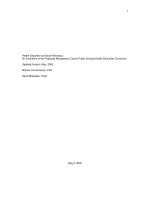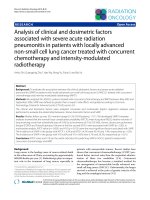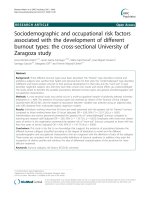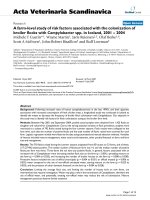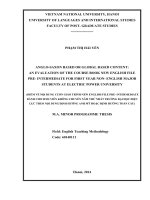An evaluation of antibiotic profile, molecular characterization and risk factors associated with carbapenem resistant non fermentative gram negative isolates in a tertiary care centre
Bạn đang xem bản rút gọn của tài liệu. Xem và tải ngay bản đầy đủ của tài liệu tại đây (290.37 KB, 10 trang )
Int.J.Curr.Microbiol.App.Sci (2017) 6(5): 1057-1066
International Journal of Current Microbiology and Applied Sciences
ISSN: 2319-7706 Volume 6 Number 5 (2017) pp. 1057-1066
Journal homepage:
Original Research Article
/>
An Evaluation of Antibiotic Profile, Molecular Characterization and Risk
Factors Associated with Carbapenem Resistant Non Fermentative Gram
Negative Isolates in a Tertiary Care Centre
N. Grover1, N.K. Das2*, M. Kumar3, R. Sriram1, V.L. Dudhat4, S. Prasanna5 and P. Pandit6
1
Department of Microbiology, Armed Forces Medical College, Pune, Maharashtra, India
2
Department of Microbiology, Dr D Y Patil Vidyapeeth Medical College,
Pimpri, Pune-411018, India
3
Department of Lab Sciences & Molecular Medicine, Army Hospital R & R, Delhi, India
4
Department of Microbiology, Microbiology and HIC Sahyadri Speciality labs, Pune, India
5
Department of Microbiology, Shri Sathya Sai Medical College and Research Institute,
Ammapettai, Kancheepuram- 608103, India
6
Gd Spl (Microbiology) Command Hospital, Kolkata, India
*Corresponding author
ABSTRACT
Keywords
Antibiotic profile,
Molecular
characterisation,
Carbapenem
resistant non
fermentative Gram
negative bacteria
.
Article Info
Accepted:
12 April 2017
Available Online:
10 May 2017
Non-fermentative Gram negative bacteria (NFGNB) can cause serious infections in hospitalised
patients. There has been an increase in resistance to carbapenems which is worrying as they are
considered as antibiotics of last resort. Carbapenemases are responsible for carbapenem resistance.
Study was undertaken to evaluate antibiotic profile, to ascertain risk factors associated and to detect
genes responsible for carbapenem resistance in NFGNB isolates from acute wards of a tertiary care
centre. The study was carried out in an urban tertiary care centre. Samples were collected from
patients of acute wards and relevant clinical history was collected. Imipenem resistance detection
and antibiotic susceptibility was done. A multiplex PCR was done on imipenem resistant isolates for
detection of resistant genes. A total of 296 isolates were collected. Acinetobacter baumannii (132)
followed by Pseudomonas aeruginosa (121) were the predominant isolates. OXA-51(72) and NDM
were the predominant genes detected in Imipenem resistant A. baumannii and Pseudomonas
aeruginosa (39). The carbapenem resistance in NFGNB in our hospital setting is mostly because of
VIM, NDM, OXA-23, OXA-51. Constant monitoring of the incidence of such organisms in critical
areas of the hospital, prompt recognition and getting rid of them is the only important preventive
strategy.
Introduction
Among the non-fermentative Gram negative
bacilli (NFGNB), Pseudomonas aeruginosa is
considered a major pathogen; however in
recent years other non-fermenters have also
caused serious infections that place
hospitalised patients at serious risk largely
because of high intrinsic antibiotic resistance
in these bacteria (Hancock, 1998; Su et al.,
2009). Non-fermenters are generally multidrug resistant, with an increase in resistance
to oxyimino-cephalosporins and carbapenems
in the last two decades. Resistance not only
compromises treatment but also leads to
increased mortality, and inflated cost in
hospitals (McGowan, 2006; Slama, 2008).
Carbapenems are stable to most β-lactamases
including AmpC β-lactamases and extended
spectrum β-lactamases (ESBL). Hence
carbapenems are used as antibiotics of last
1057
Int.J.Curr.Microbiol.App.Sci (2017) 6(5): 1057-1066
resort for treating infections due to multidrugresistant Gram negative bacteria (Zhanel et
al., 2007; Lee et al., 2003). Carbapenemases
are enzymes secreted by bacteria which are
relatively new and they have the ability to
spread very rapidly. They confer resistance to
the carbapenems as well as extended
spectrum cephalosporins. There are various
systems to classify them. According to the
Ambler
classification
scheme,
carbapenemases fall into class A (KPC, SME,
NMC-A, IMI, GES), class B (IMP, VIM,
NDM), and D (OXA enzymes) (Paterson et
al., 2005). Carbapenemases are spreading
throughout the world as the genes for most
carbapenemases are plasmid mediated and are
located on mobile cassettes inserted on
variable regions in integrons resulting in
enhanced potential for expression and
dissemination (Henry et al., 2011).
Identification
and
detection
of
carbapenemases producing organisms will
guide the hospital infection control committee
in preventing spread of multidrug resistant
isolates and can quickly detect any outbreak
of these organisms in critical care settings of
hospital.
Materials and Methods
The study was carried out in the Department
of Microbiology, of an urban tertiary care
centre of western Maharashtra from Dec 2012
to Jul 2014 after institutional ethical
committee clearance. Consecutive, non-repeat
isolates of NFGNB were collected from
clinical samples from inpatients of acute
wards of a tertiary care centre. Detailed
clinical history was recorded.
Sample processing
The clinical samples were processed and
speciation of isolates was done by standard
laboratory protocols (Collee et al., 2011;
Govan et al., 2011).
Antibiotic susceptibility testing
Screening for carbapenem resistant NFGNB
from the routine clinical samples was done by
using 10μg imipenem discs (Fig. 1).
Antibiotic
susceptibility
testing
was
performed on all NFGNB isolates by using
Kirby-Bauer disc diffusion method as per
CLSI guidelines 2012 (Fig. 2 and 3) (CLSI,
2012).
Genotypic methods
The presence of genes responsible for
carbapenemases production like KPC,
MBLs(VIM, NDM) and Oxacillinases OXA48, OXA-23, OXA-24, OXA-51, OXA-58
was done by PCR. In house strains were used
as positive and negative controls.
Primers and cycling conditions
Primers used for detection of OXA-23, OXA24, OXA-51 and OXA-58 were referenced
from a study by Huang et al., and for NDM,
KPC, VIM and OXA-48 by Van der Zee et
al., Monoplex PCR was performed on all
isolates that were positive by multiplex PCR
to differentiate between (OXA-23 and OXA51), (NDM and VIM) (Fig. 4 and 5).
Statistical analysis
Data in the present study was entered into
spreadsheet (Excel 2007; Microsoft) for
analysis. Unpaired student’s t-test was used to
measure test of significance for quantitative
variables and Chi-square test for qualitative
variables. Yate’s correction was applied to the
Chi-square test whenever frequency of
variable was less than 5. All tests were two tailed and a p value <0.05 was taken as
“Significant”. All tests were done using
online GraphPad software:
/>ency2/and
/>
1058
Int.J.Curr.Microbiol.App.Sci (2017) 6(5): 1057-1066
Results and Discussion
A total of 296 isolates of NFGNB were
collected. Most common isolate collected
during the present study was Acinetobacter
baumannii (132) followed by Pseudomonas
aeruginosa
(121),
Stenotrophomonas
maltophilia (20), Alkaligenes faecalis (8),
Burkholderia cepacia (4), Sphingomonas
paucimobilis
(4),
Achromobacter
denitrificans (2), Pseudomonas fluorescens
(2),
Pseudomonas
putida
(2)
and
Burkholderia pseudomallei (1). NFGNB was
most commonly isolated from tracheal
aspirate (101) followed by blood (76), pus
(51), urine (25), sputum (11), body fluids (13)
and other miscellaneous samples (19). Most
samples in the present study were received
from ICU-surgery (128) followed by general
surgery ward (58), ICU-medicine (54),
general medicine ward (24), general
orthopaedics ward (14) and ENT ward (6).
94 isolates of A.baumannii were imipenem
resistant. 63 isolates of P.aeruginosa were
imipenem resistant. Thirty isolates of nonfermenters other than A.baumannii and
P.aeruginosa were imipenem resistant. More
than 90% of imipenem resistant isolates of A.
baumannii (IRAB) were resistant to most
other antibiotics. Piperacillin was resistant in
all isolates. Polymixin B and Colistin were
sensitive in 95.74% and 91.48% of IRAB.
More than 90% of isolates of imipenem
resistant Pseudomonas aeruginosa (IRPA)
were resistant to most antibiotics. Piperacillin
was resistant in all imipenem resistant
isolates. 95.23% of IRPA were sensitive to
aztreonam. Polymixin B and Colistin were
sensitive in 98.41% and 96.82% of IRPA
isolates.
of isolates, OXA-23 in 62, NDM in 56 and
VIM in 26 isolates. 42 isolates had OXA-23,
OXA-51 and NDM combination. KPC, OXA24, OXA-48, OXA-58 was not detected in
any IRAB isolate. In 14 IRAB isolates no
resistance genes was detected.
Out of 63 IRPA isolates NDM was present in
39, VIM in 33 and OXA-48 in 5 isolate.
OXA-23, OXA-24, OXA-51, OXA-58 and
KPC were not detected in any isolate. In 16
isolates no genes under study were detected.
PCR was negative for any gene under study in
non-fermenters other than A. baumannii and
P. aeruginosa.
Risk factor assessment (Table 1)
Overall 72 patients died out of 296 patients
harbouring NFGNB. Fifty one patients died
from whom imipenem resistant strains were
isolated. However there was no statistical
significance seen in death of patients between
imipenem sensitive and resistant isolates.
The mean duration of hospital stay in IRAB
was 33.22 days and in ISAB was 22.11 days.
The difference in mean duration of hospital
stay in cases of IRAB and ISAB was not
statistically significant. The mean duration of
hospital stay in IRPA was 39.10 days and
22.38 days in ISPA. The difference in mean
duration of hospital stay in ISPA and IRPA
was statistically significant with a p value of
0.0121.Previous history of hospitalisation was
seen in 33 patients infected with IRAB and in
12 patients with ISAB. The difference was
not found to be statistically significant.
Previous history of hospitalisation was seen in
32 patients infected with IRPA and in 19
patients with ISPA. The difference was found
to be statistically significant with a p value of
0.0447.
PCR
Out of 94 IRAB, OXA-51 was present in 72
Surgical intervention was there in 57 patients
infected with IRAB and in 15 patients with
1059
Int.J.Curr.Microbiol.App.Sci (2017) 6(5): 1057-1066
ISAB patients. The difference was found to
be statistically significant with a p value of
0.0270. Surgical intervention was seen in 40
patients infected with IRPA and in 25 patients
with ISPA patients. It was statistically
significant with a p value of 0.0246.
39 patients infected with IRAB and 10
patients infected with ISAB had mechanical
ventilation. The difference was not found to
be statistically significant. Intervention of
mechanical ventilation was found to be a
statistically significant risk factor for infection
with IRPA with a p value of 0.0490.
Treatment with carbapenems earlier in course
of disease or in recent past was not found to
be a significant risk factor.
Fifty seven patients with IRAB and 12
patients
with
ISAB
were
immunocompromised. This was found out to
be a significant risk factor with a p value of
0.0243. 44 patients with IRPA and 29 patients
with
ISPA
infection
were
immunocompromised. This was statistically
significant with a p value of 0.0258.
The burden of infectious diseases is among
the highest in India making the treatment with
antibiotics play a huge role in determining
mortality and morbidity (Choudhury et al.,
2012). Ease of mobility by human due to
travel, allow different bacterial plasmid and
clones to be transported to different countries.
Selection pressure for carbapenem resistance
is a major concern as only a few antibiotics
are there which are reserved for resistance
beyond the carbapenems. Most isolates
however still are sensitive to colistin and
tigecycline.
A total of 296 samples were collected during
the study period. The most common isolate
was Acinetobacter baumannii, followed by
Pseudomonas
aeruginosa.
Imipenem
resistance was seen in 63.1% of total isolates.
Literatures from SE Asia mention prevalence
of carbapenem resistance in non-fermenters
varying from 36 to 90% (Goel et al., 2011).
Considering sample wise distribution, most
samples from which non-fermenters were
isolated were those from tracheal aspirate
(34.12%) followed by blood (25.67%), pus
(17.22%), and urine (8.44%). Amudhan et al.,
had predominant NFGNB isolates from
respiratory secretions (Amudhan et al., 2012).
Kalidas et al., isolated non-fermenters
predominantly from pus (Rit et al., 2013).
71.21% of Acinetobacter baumannii were
imipenem resistant. Most of these IRAB
isolates were from ICU-surgery followed by
ICU-medicine and surgery ward. This is
similar to the finding by Baran et al., (2008)
who found IRAB more in ICUs than in wards
and Khajuria et al., (2014) who reported that
among his imipenem resistant isolates most
isolates were from ICU-surgery.
52.06% of Pseudomonas aeruginosa were
imipenem resistant. Bhalerao, Behera and
Onguru et al., (2010; 2008; 2008) have
reported imipenem resistance in P.
aeruginosa at 67.5%, 69% and 44.1%
respectively. Most IRPA came from ICUsurgery (39.68%) followed by ICU-medicine
and surgery wards (20.63%).
Among IRAB, 76.59% of isolates were
positive for OXA-51, 65.95%were OXA-23
positive. Khajuria et al., (2014) had 44.76%
of his isolates positive for OXA-51 and
52.38% were positive for OXA-23. His study
also found OXA-58, OXA-24 in his isolates,
which were lacking in our study. 9.5%
isolates were both OXA-23 and OXA-51
positive. 44.68%isolates were positive for
OXA-23, OXA-51 and NDM. 1.06% of
isolates were positive for only NDM or VIM.
Total 27.65% of isolates were positive for
VIM. Amudhan et al., (2012) reported
45.68% of resistant isolates to harbour VIM.
1060
Int.J.Curr.Microbiol.App.Sci (2017) 6(5): 1057-1066
11.7%isolates were positive for OXA-23,
OXA-51, NDM and VIM. Niranjan et al.,
reported that OXA-51, VIM-1 and IMP-1
were present in all isolates of A. baumannii.
They also found OXA-23 in 46.66% of
isolates and no isolate was positive for OXA24 and OXA-58 (Niranjan et al., 2013). In
our study also multiple resistance genes were
seen to be present in a single isolates and
there was presence of MBL genes with class
D carbapenemases and none of the isolates
were positive for OXA-24 and OXA-58. In
the present study we found NDM in 59.57%
of imipenem resistant isolates whereas
Niranjan et al., found NDM in about 30%
isolates and Farzana found 26.6% of IRAB to
be NDM. In all 71.27% of IRAB were MBL
by molecular methods. Farzana et al., 2013
found all his IRAB as MBL producers. The
presence of NDM emphasizes the instant
reception of A.baumannii to carbapenemase
genes. OXA-23 is present in class I integrons
which can also carry genes for resistance to
drugs
like
aminoglycosides
and
fluoroquinolones. These integrons can be
easily transferred to other gram negative
bacteria by “genetic capitalism”. No isolate
was positive for OXA-24, OXA-58, KPC and
OXA-48. The isolates negative for test genes
in PCR can have genes other than these test
genes for carbapenem resistance. In IRPA,
overall 61.9% of isolates were positive for
NDM, 52.38% for VIM and 7.9% were OXA48 positive. 42.85% had both NDM and VIM,
14.28% of isolates were only NDM positive
and 9.52% were only VIM positive. Farzana
detected NDM in 18.75% of IRPA isolates.
Chaudhary et al., (2014) reported the
presence of OXA-48 in their carbapenem
resistant P.aeruginosa isolates. We found
7.9% of isolates to be positive for OXA-48.
25.39% of IRPA isolates were negative for
any resistance genes tested. In imipenem
resistant isolates of A.baumannii it was seen
that most isolates were resistant to first line
antibiotics. However the isolates were
consistently susceptible to colistin and
polymixin Khajuria et al., and Shivaprasad et
al., found that most of their isolates were
susceptible to tigecycline and colistin. The
same observation was seen in case of
P.aeruginosa in which also most of the first
line antibiotics were resistant over 90%
except for polymixin B, colistin, and
aztreonam.
Table.1 Comparison between imipenem sensitive and resistant isolates considering various risk
factors
Risk factors
Mean duration of
hospital stay (SD)
Previous H/O
hospitalization
Surgical intervention
Mechanical
ventilation
Treatment
history
with carbapenems
Immunocompromised
status
No of
No of
p
No of
No of
p
IRAB ISAB value IRPA ISPA value
33.22
22.11 0.1182 39.10
22.38 0.0121
(41.09) (22.61)
(41.05) (29.61)
33
12
0.6987
32
19
0.0447
57
15
0.0270
40
25
0.0246
39
10
0.1023
22
11
0.0490
31
7
0.0944
15
11
0.5169
57
12
0.0243
44
29
0.0258
1061
Int.J.Curr.Microbiol.App.Sci (2017) 6(5): 1057-1066
Fig.1 Imipenem resistant Pseudomonas aeruginosa
Fig.2 Antibiotic profile of imipenem resistant A. baumannii
Fig.3 Antibiotic profile of imipenem resistant Pseudomonas aeruginosa
100%
90%
80%
70%
60%
50%
40%
30%
20%
10%
0%
1
3
63
60
60
62
59
60
2
54
62
53
53
56
55
61
Resistant
Sensitive
0
3
1
4
9
3
1062
10
10
7
8
Int.J.Curr.Microbiol.App.Sci (2017) 6(5): 1057-1066
Fig.4 Gel electrophoresis result showing OXA-23 (116 bp), OXA-51 (112 bp), MW-Molecular
marker, NC-negative control, PC-positive control
Fig.5 Gel electrophoresis result showing NDM (83bp), VIM (92bp), OXA-48 (438 bp) MMMolecular marker, NC-negative control
Onguru et al., (2008) reported the presence of
more than 70% resistance to most antibiotics
in IRPA. Amudhan et al., and Behera et al.,
found that 91.8% and 87.5% of their
imipenem resistant P. aeruginosa isolates
were polymixin B sensitive. Colistin and
polymixin B are considered as drugs of last
resort in carbapenem resistant NFGNB hence
should be used judiciously (Al-Anazi, 2014).
The patients harbouring IRPA isolates had a
significant increase in duration of stay in
hospital. Onguru et al., (2008) reported that
longer duration of hospital stay was
associated with infection with IRPA.
Previous history of hospitalisation was seen
as a significant finding for infection with
IRPA infection. Zavascki and Harris et al.,
(2005; 2002) reported hospitalisation in the
previous year as a significant risk factor for
infection with IRPA. History of surgical
1063
Int.J.Curr.Microbiol.App.Sci (2017) 6(5): 1057-1066
intervention was found to be a significant
finding for harbouring IRAB and IRPA
infection. Baran reported that surgical
intervention was significantly associated with
infection with IRAB infection. Mechanical
ventilation was seen to be associated with
IRPA infection. Zavascki et al., (2005) had
mechanical ventilation as a significant risk
factor
for
infection
with
IRPA.
Immunocompromised state was found to be a
significant risk factor for IRAB and IRPA
infection.
Simple methods like adherence to hand
hygiene practices, suction and ventilator
decontamination and environmental cleaning
can go a long way to reduce containment of
infections. Hence consensus and co-operation
among hospital staff, strong infection control
guidelines and antibiotic stewardship must be
in place in critical care settings to prevent
infection due to multidrug resistant bacteria
In conclusion, multiple mechanisms of
carbapenem resistance are present in NFGNB.
The carbapenem resistance mechanism in
NFGNB in our hospital setting is mostly
because of metallo-β-lactamases (VIM,
NDM) and Oxacillinases enzyme (OXA-23,
OXA-51 type). One or more types of
mechanisms might be acting synergistically to
cause high level carbapenem resistance. The
carbapenem resistant NFGNB strains isolated
in our hospital are mainly from ICU and these
isolates are multi drug resistant. Since there
are limited treatment options against these,
continuous vigilance, early identification and
treatment is very important to prevent further
spread. Constant and regular monitoring of
the incidence of such organisms in various
critical areas of the hospital like ICU and
acute medical units, prompt recognition of
potential areas of colonisation and getting rid
of them is the only important preventive
strategy. To keep this problem in check,
simple infection control measures like proper
hand washing, adherence to infection control
guidelines and antibiotic stewardship must be
followed and time to time revision must be
done.
References
Al-Anazi, K.A., Al-Jaseer. 2014. Infections
caused by Acinetobacter baumannii in
recipients of hematopoietic stem cell
transplantation. Front Oncol., 4: 186.
Amudhan, M.S., Sekar, U., Kamalanathan,
A., Balaraman, S. 2012. blaIMP and
blaVIM mediated carbapenem resistance
in Pseudomonas and Acinetobacter
species in India. J. Infect. Dev. Ctries.,
6(11): 757-62.
Baran, G., Erbay, A., Bodur, H., Onguru, P.,
Akinci, E., Balaban, N., et al., 2008. Int.
J. Infect. Dis., 12: 16-21.
Behera, B., Mathur, P., Das, A., Kapil, A.,
Sharma, V. 2008. An evaluation of four
different phenotypic techniques for
detection
of
metallo-β-lactamase
producing Pseudomonas aeruginosa.
Indian J. Med. Microbiol., 26(3): 233-7.
Bhalerao, D.S., Roushani, S., Kinikar, A.G.,
Akhter, I. 2010. Study of metallo-beta
lactamase producing Pseudomonas
aeruginosa in Pravara rural hospital.
Pravara Med. Rev., 2(3): 16-9.
Chaudhary, M., Payasi, A. 2014. Prevalence
genotyping of Escherichia coli and
Pseudomonas
aeruginosa
clinical
isolates for oxacillinase resistance and
mapping susceptibility behaviour. J.
Microb. Biochem. Technol., 6(2): 63-7.
Choudhury, R., Panda, S., Singh, D.V.
Emergence and dissemination of
antibiotic resistance: A global problem.
Indian J. Med. Microbiol., 30: 384-90.
Chroma, M., Kolar, M. 2010. Genetic
methods for detection of antibiotic
resistance: Focus on Extended-spectrum
β-lactamases. Biomed. Pap Med Fac
Univ. Palacky Olomouc Czech Repub.,
154(4): 289–96.
1064
Int.J.Curr.Microbiol.App.Sci (2017) 6(5): 1057-1066
CLSI. 2012. Performance standards for
antimicrobial susceptibility testing;
twenty-second
informational
supplement. CLSI document M100S22. Wayne, PA: Clinical and
Laboratory Standards Institute.
Collee, J.G., Duguid, J.P., Fraser, A.G.,
Marmion, B.P., Simmons, A. 2011.
Laboratory strategy in the diagnosis of
infective syndromes. In: Collee JG,
Fraser AG, Marmion BP, Simmons A,
editors. Mackie & McCartney Practical
Medical Microbiology. 14th ed. India:
Churchilll Livingstone.
Farzana, R., Shamsuzzaman, S.M., Mamun,
K.Z. 2013. Isolation and molecular
characterisation of New Delhi metalloβ-lactamase-1 producing superbug in
Bangladesh. Emerging Problems in
Infectious diseases, 7(3): 161-8.
Goel, N., Wattal, C., Oberoi, J.K.,
Raveendran, R., Datta, S., Prasad, K.J.
2011. Trend analysis of antimicrobial
consumption and development of
resistance in non-fermenters in a tertiary
care hospital in Delhi, India. J.
Antimicrob. Chemother., 60(7): 162530.
Govan,
J.R.W.
2011.
Pseudomonas,
Stenotrophomonas, Burkholderia. In:
Collee JG, Fraser AG, Marmion BP,
Simmons A, editors. Mackie &
McCartney
Practical
Medical
Microbiology. 14th ed. India: Churchilll
Livingstone.
Hancock,
R.E.W.
1998.
Resistance
mechanism in Pseudomonas aeruginosa
and other Non-fermentative Gramnegative bacteria. Clin. Infectious Dis.,
27(suppl 1): S93-9.
Harris, A., Smith, D., Johnson, J., Bradham,
D., Roghmann, M. 2002. Risk factors
for imipenem resistant P.aeruginosa
among hospitalised patients. Clin.
Infect. Dis., 34: 340-5.
Henry,
D.A.,
Speert,
D.P.
2011.
Pseudomonas. In: Versalovic J, Carroll
KC, Funke G, Jorgensen JH, Landry
ML, Warnock DW, editors. Manual of
Clinical
Microbiology.
10th
ed.
Washington, DC: ASM Press.
Huang, X.Z., Cash, D.M., Chahine, M.A.,
Nikolich, M.P., Craft, D.W. 2012.
Development and validation of a
multiplex Taqman real-time PCR for
rapid detection of genes encoding four
types of class D carbapenemase in
A.baumannii. J. Med. Microbiol., 61:
1532-7.
Khajuria, A., Praharaj, A.K., Kumar, M.,
Grover,
N.
2014.
Molecular
characterisation of carbapenem resistant
isolates of Acinetobacter baumannii in
an intensive care unit of a tertiary care
centre. J. Clin. Diag Res., 8(5): 38-40.
Lee, K., Lim, Y.S., Yong, D., Yum, J.H.,
Chong, Y. 2003. Evaluation of the
Hodge Test and the Imipenem-EDTA
Double-Disk
Synergy
Test
for
Differentiating Metallo-β-LactamaseProducing Isolates of Pseudomonas spp.
and Acinetobacter spp. J. Clin.
Microbiol., 4623–9.
McGowan, J.E. 2006. Resistance in nonfermenting Gram-negative bacteria:
multidrug resistance to the maximum.
Am. J. Med., 119 Suppl 1: S29–36.
Niranjan, D.K., Singh, N.P., Manchanda, V.,
Rai, S., Kaur, S. 2013. Multiple
carbapenem hydrolysing genes in
clinical isolates of Acinetobacter
baumannii. Indian J. Med. Microbiol.,
31(3): 237-41.
Onguru, P., Erbay, A., Bodur, H., Baran, G.,
Akinci, E., Balaban, N., et al.,
Imipenem
resistant
Pseudomonas
aeruginosa: risk factors. J. Korean Med.
Sci., 23: 982-7.
Paterson, D.L., Bonomo, R.A. 2005.
Extended-spectrum β-lactamases: a
1065
Int.J.Curr.Microbiol.App.Sci (2017) 6(5): 1057-1066
clinical update. Clin. Microbiol. Rev.,
18: 657–86.
Rit, K., Nag, F., Raj, H.J., Maity, P.K. 2013.
Prevalence and susceptibility profiles of
non-fermentative gram-negative bacilli
infection in a tertiary care hospital of
Eastern India. Indian J. Clin. Practice,
24(5): 451-5.
Shivaprasad, A., Antony, B., Shenoy, P.,
MBL & Carbapenemase Production in
A.baumannii. J. Clin. Diag. Res., 8(5):
5-8.
Slama, T.G. 2008. Gram-negative antibiotic
resistance: there is a price to pay. Crit.
Care, 12 Suppl 4: S4.
Su, S.C., Vaneechoutte, M., Dijkshoorn, L.,
Wei, Y.F., Chen, Y.L., Chang, T.C.
2009. Identification of non-fermenting
Gram-negative bacteria of clinical
importance by an oligonucleotide array.
J. Med. Microbiol., 58(5): 596–605.
Van der Zee, A., Roorda, L., Bosman, G.,
Fluit, A.C., Hermans, M., Smits, P.H. et
al. Multicentre evaluation of real-time
multiplex PCR for detection of
carbapenemase genes OXA-48, VIM,
NDM and KPC. BMC Infectious Dis.,
14(27): 1471-2334.
Zavascki, A.P., Cruz, R., Coldani, L. 2005.
Risk factors for imipenem resistant
Pseudomonas aeruginosa comparative
analysis of two case control studies in
hospitalised patients. J. Hosp. Infect.,
59: 96-101.
Zhanel, G.G., Wiebe, R., Dilay, L., Thomson,
K., Rubinstein, E., Hoban, D.J., et al.
2007.
Comparative
review
of
carbapenems. Drugs, Volume 67(7):
1027-52.
How to cite this article:
Grover, N., N.K. Das, M. Kumar, R. Sriram, V.L. Dudhat, S. Prasanna and Pandit, P. 2017. An
Evaluation of Antibiotic Profile, Molecular Characterization and Risk Factors Associated with
Carbapenem Resistant Non Fermentative Gram Negative Isolates in a Tertiary Care Centre.
Int.J.Curr.Microbiol.App.Sci. 6(5): 1057-1066. doi: />
1066
